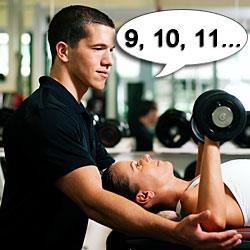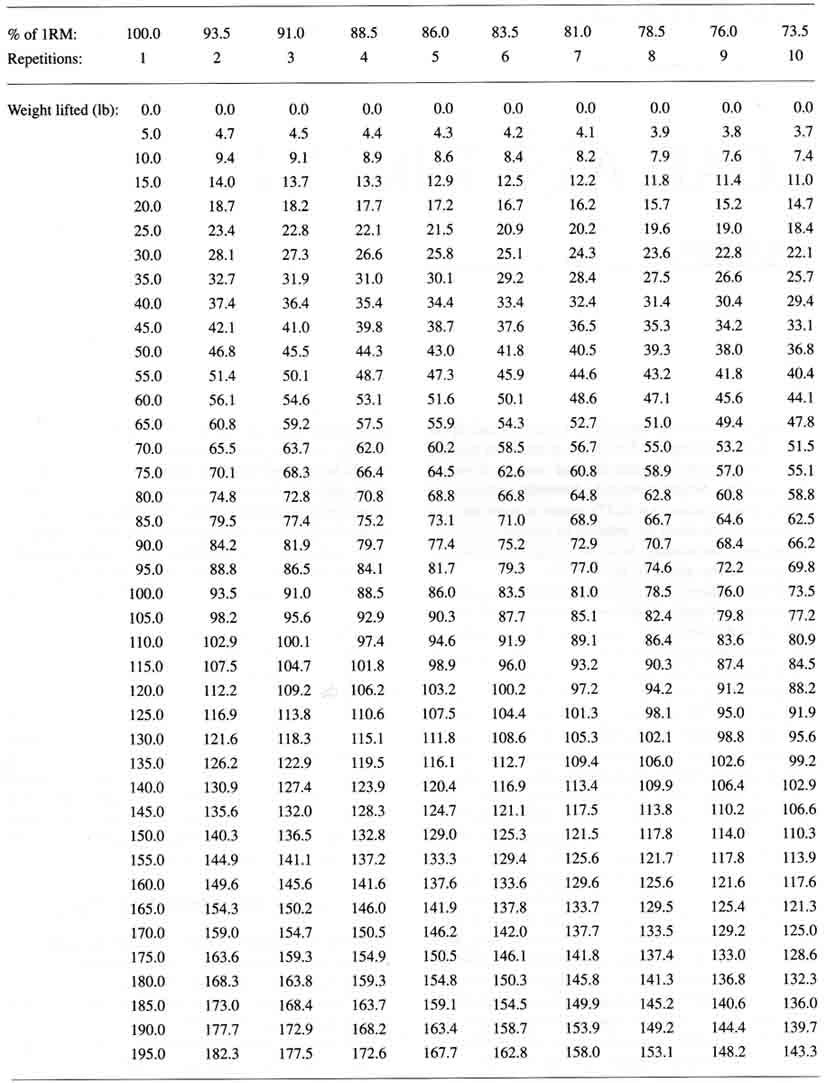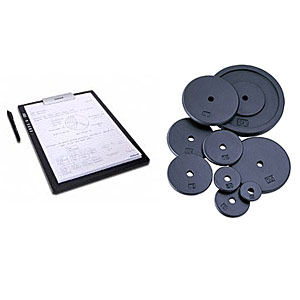- Like
- SHARE
- Digg
- Del
- Tumblr
- VKontakte
- Flattr
- Buffer
- Love This
- Save
- Odnoklassniki
- Meneame
- Blogger
- Amazon
- Yahoo Mail
- Gmail
- AOL
- Newsvine
- HackerNews
- Evernote
- MySpace
- Mail.ru
- Viadeo
- Line
- Comments
- Yummly
- SMS
- Viber
- Telegram
- JOIN
- Skype
- Facebook Messenger
- Kakao
- LiveJournal
- Yammer
- Edgar
- Fintel
- Mix
- Instapaper
- Copy Link
Everything You Need to Know About Sets and Reps
 Why Are Sets and Reps Important?
Why Are Sets and Reps Important?
Sets and repetitions are fundamental weight training concepts to understand thoroughly. When you perform a specific exercise, you typically repeat a specific action a certain number of times, or reps. Reps is short for repetitions. The number of repetitions you perform before you stop is a set.
Understanding sets and reps is important because everything you do during a workout is organized into sets and repetitions.
Phases of Each Repetition
There are three phases of each repetition. During each rep, it is very, very important to focus on all three phases in order to get a complete set and an optimal workout.
Concentric Phase
The concentric part of a rep is the muscle-shortening phase. You can think of the concentric phase as the part of a lift when you raise the weight against gravity. You usually exhale your breath as you complete the concentric phase.
Many weight lifters focus solely on the concentric phase. This is a HUGE mistake, because your muscles respond better to training when you focus on all phases of each rep. Don’t waste your time by only focusing on the concentric phase. You’ll get more out of your workouts by dividing your focus between each of the three phases.
Eccentric Phase
The eccentric part of a rep is the muscle-lengthening phase. You can think of the eccentric phase as the part of a lift when you lower the weight under control, resisting gravity so that the weight doesn’t drop too fast. Most of the time you exhale your breath during the eccentric phase.
This is the most neglected part of the rep. Your muscles can handle a heavier load during the eccentric phase, which makes it important to always lower the weight slowly under control.
There is even an advanced technique called “eccentric negatives”. Negatives involve using a weight which is heavier than you can lift concentrically. This helps build muscular strength so you can lift heavier and heavier loads as you continue your training.
Isometric Phase
The isometric portion of a rep is when the muscle is neither shortening or lengthening, but is still under tension. The muscle is busily contracting, but remaining the same length. You will hold your breath for a beat during the short isometric phase.
You can think of the isometric phase as the action of your muscles when you push against a brick wall. Your muscles are working like crazy, but neither your muscles nor the brick wall are moving.
The isometric part of the rep is often neglected. It is important to pause for at least a split second after each eccentric (lowering) phase. It is essential to be able to stabilize any weight isometrically before heavier loads can be used.
Isometric-only training was used before weight lifting became mainstream. Believe it or not, isometric-only training is very effective for building muscle.
The main disadvantage of isometric training is that your muscles are not brought through their full range of motion. Therefore, only the range of motion in which you’re exercising is strengthened during a static rep.
A wall sit, in which you sit against a wall with your legs at a 90 degree angle is a good example of an isometric exercise.
The leg muscles only are strengthened in that angle. Thus, it’s a good idea to perform complete sets and reps using all 3 phases of the lift for your legs as well as your whole body.
Several Exercise Factors Determine How Many Sets & Repetitions to Perform
Quality should always be more important that quantity for each set and rep of each exercise. This holds true regardless of the exercise or the phase of training. The only exception to this rule is if your specific goal deals with a quantity. If you want to do 1000 push-ups, you will have to train sacrificing form some of the time. You will be better off health- and fitness-wise if you set goals which support quality over quantity, though.
Exercise Form
Weight training is not a counting exercise. There is no magic number when it comes to sets and reps. It is most important to perform a quality set of quality reps than 10, 15, or 20 reps. Since the quality of sets and reps is most important, rep quality determines how many sets and reps you perform. If you are unable to keep up proper form for an exercise for each rep of your set, you should stop.
Failure
Failure is when you try to complete another repetition with perfect form, but your muscles are completely fatigued. A perfect set is one in which you complete just under the desired number of repetitions. If you pick up a certain weight with the intention of completing 10 repetitions and can only complete 9.5 with perfect form, you have succeeded by reaching failure.
If you reach failure during the first set, some experts claim that you do not need to perform another set. This is debatable, but you can try and see what works best for you.
Rest in Between Sets
The amount of time you take to rest in between sets has a direct correlation to your ability to perform the next set. Weight training is an anaerobic exercise, so full recovery in between sets is around a minute.
Muscles Being Trained
Your body’s muscles are composed of two different types of muscle fibers: slow-twitch and fast-twitch. Your genetics and training can effect the ratio of type I to type II muscle fibers in your body.
- Slow-twitch muscle fibers (type I)
- Built for endurance and highly resistant to fatigue. Muscles composed of primarily slow-twitch fibers, such as the abdominals, respond better to higher repetitions.
- Fast twitch muscle fibers (type II)
- Built for strength and power, thus less resistant to fatigue. Fast-twitch muscle fibers respond better to a low or moderate range of reps. Most muscles in your extremities are composed of type II muscle fibers.
Phase of Training
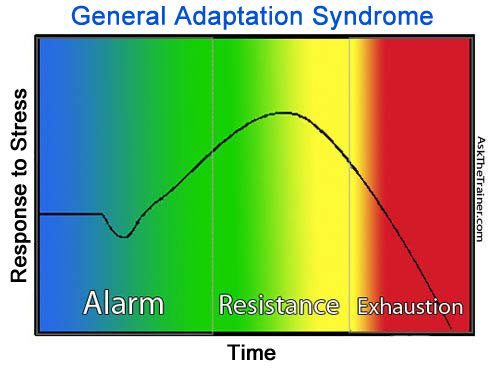
Your body has the ability to adapt to almost any activity. If you perform the same number of sets and reps without ever changing up your routine, your body will plateau.
A plateau is when your gains in fitness come to a standstill. Plateau is represented by the exhaustion phase of the General Adaptation Syndrome model on the right.
If you train properly, you should lift in phases. This is called periodization, and it is the basis the training program of all serious athletes, bodybuilders, and strength trainers. Periodization adjusts weight training volume to account for adaptation.
Simply put, periodization requires you to cycle through periods of higher and lower volume (sets and reps) in your training program. You can think of periodization as separate training periods of lighter weights and more reps alternating with periods of heavier weights and less reps.
How to Know Which Phase is Appropriate
Your Goals Determine Which Phase of Training You Should Use
If your goals are more strength-related, you should be in the lower reps with higher weight phase for a majority of the time. If your goals are body composition-related such as weight loss or muscle gain / muscle toning, you should spend most of your time in the higher reps phase.
Even if you are not a competitive athlete or bodybuilder, you can benefit significantly from using the periodization model. With the science of weight training on your side, you will get optimal results by avoiding the frustrating plateau. Periodization also helps prevent overtraining syndrome.
You go through alarm, resistance, and adaptation phases of periodization before you take your active rest and recovery and start again. If you don’t follow the periodization protocol, you will most likely enter the exhaustion phase, which will hinder your results. The GAS or General Adaptation Syndrome is outlined in the chart above.
When to Switch Up Sets and Reps
Like most exercise-related issues, when to switch up sets and reps varies from person to person. Athletes who have strict strength and conditioning programs have a competition season around which to plan their different periods.
For a normal person just looking to be in great shape, the time to switch phases is when you start to plateau. When if you start to feel less energized after workouts, feel as if you’re losing strength, or get bored, it is a great time to take a short active rest before switching to the next training period.
Take an Active Rest Period Between Cycles
A very important part of periodization is rest. If you have been going with heavy sets and reps for a while and are ready to switch to a cycle of light sets and reps, a week of active rest will make a big difference to your success in the next phase.
Active rest means you can be active, but avoid structured exercise such as jogging and weight training. After you have your active rest period, the new phase of training will cause the alarm in which your body has to adapt to (lose weight, gain muscle). Check out our article on Active Recovery for Health and Fitness to learn tips for maximizing your recovery period.
Guidelines for Sets and Reps
The number of sets and reps you should perform is not set in stone. When you hear “low reps” it usually means 8 or less reps per set. “High reps” usually means 12-20 repetitions per set.
There is no complex formula to determine how many sets and reps you should perform. Sets and repetitions are a hotly debated topic in health and fitness field because there really is no absolute answer.
Some “experts” say that one set per body part is all you need. Other “experts” scoff at the first set “experts” and say that a single set is ineffective.
You Can Establish Your Own Guidelines for Sets and Reps
Trial and error is the only way you can determine which sets and reps scheme will work for you. There are many training modalities out there, and what works for someone else might not work for your, so it is best to try as many as you can to see which yields the most results.
Here Are Some Very General Guidelines to Get You Started:
Beginners
2 Sets of 15-20 Repetitions
If you are a beginner, it is very important that your body learns proper form. During the beginning phase of weight training, your nervous system is being trained more than your muscles.
Your neurological system is not familiar with certain motions, so it is best to perform slow and controlled motions for a high number of reps. This will allow your neurological system to catch up to your muscular system.
Once your nervous system is able to recruit the muscle groups properly, it is time to increase the weight and move on to the next phase. It usually takes about a month for your body to neurologically adapt.
Intermediate
3 Sets of 8-12 Repetitions
Now that your nervous system has adapted, your muscles are ready to accept heavier loads. After the beginning phase, your muscle recruitment patterns are good enough to recruit a large percentage of your muscle groups during each exercise.
At this point, an extra set can be helpful if your goal is to develop larger muscles, also known as hypertrophy. An added set will increase your training volume.
During the intermediate phase, you will start to feel more fatigue in the targeted muscle during the exercise. During all your sets and reps, it is very important to feel the muscular contraction in the correct muscle so you know you are performing the exercise correctly.
When you lift for a given number of reps, you should choose a weight which you think you can lift only that many times and no more. If you can perform the desired number of reps without fatiguing, you may want to increase the weight for the next set. Remember that a perfect set is a set to failure.
You can be in the intermediate phase for years. Many people never become advanced weight trainers. You do not have to become advanced to get results from any exercise program.
Advanced
3-5 Sets of 1-20 Repetitions
If you can control heavy and light weights with correct form and are comfortable with muscular failure, you can consider yourself advanced. At this stage you should be familiar with your own response to weight training.
Options are very open with regard to sets and reps for advanced weight trainers. To know the correct amount of weight to use for a strength-gaining program at the advanced level, it is important to determine your 1RM or 1 rep maximum for certain lifts. Once you determine the 1RM, you can accurately choose the amount of weight to use for a set of any number of reps with the load assignment chart.
As previously mentioned, whether you are advanced, intermediate, or a beginner, it is best to organize your training with the periodization model to get the best results and prevent injury.

Important Take-Home Information
You are NOT Lifting Weights, You are Contracting Your Muscles
You don’t win the pink stuffed elephant if you lift a certain weight 10 times. The prize you get for contracting your muscles is improved strength and endurance as well as a lean, toned body. Focus on a sets and reps scheme that gets you closer to your own goals, not on what other people are doing.
The Number of Sets and Reps is Not Set in Stone, So Use Trial and Error to Find What Works Best for You
Your body’s primary muscle fiber type due to your genetics helps determine how your body will respond to weight training. If your goal is to gain strength, you should definitely use the Load assignment chart to help you determine the number of sets and reps.
Rest as Little as Possible in Between Sets
Unless you are specifically trying to gain maximal strength, you should have minimal rest in between sets. Minimal rest between sets allows you to squeeze in the most volume in the least time, making your workout more time-efficient. In order to minimize rest between sets, there are different ways to organize your weight training set structure such as super-sets, tri-sets and giant sets.
Light Weights (High Reps) Do Not Tone, and Heavy Weights (Low Reps) Do Not Bulk
This is the most predominant fitness myth. A proper weight training program includes periods of low reps with heavy weights and high reps with light weights.
Whether your weight training program helps you tone or bulk up depends mostly on your diet, genetics, and sex. Women should not be afraid to lift heavy weights.
Maximize Your Workouts by Manipulating Exercise Variables Such as Sets and Reps
- Training Volume
Training volume is the most important concept to grasp if you want to get the most benefits from weight training. Training volume depends not only on sets and reps, but exercise selection and lifting speed. - Training Splits
To get the most out of weight training, make sure you understand how to structure training splits. A training split refers to which muscles or muscle groups trained each session. A good training split will help you achieve your goals more efficiently, allowing you to rest muscles while you are training others. Also learn about different types of special sets and reps. - Exercise Guides
Look an anatomy chart of all the major muscles in the human body. Click on a body part to find some of the best exercises for each muscle group. Also click on the exercise ball or other pieces of equipment to find equipment-specific exercises. - HealthTrends.com
Dialing in your sets, reps, splits, and volume is one thing, but no well structured exercise program is complete without the proper health and nutrition to match. Check out many of the latest health trends here.
Load Assignment Chart
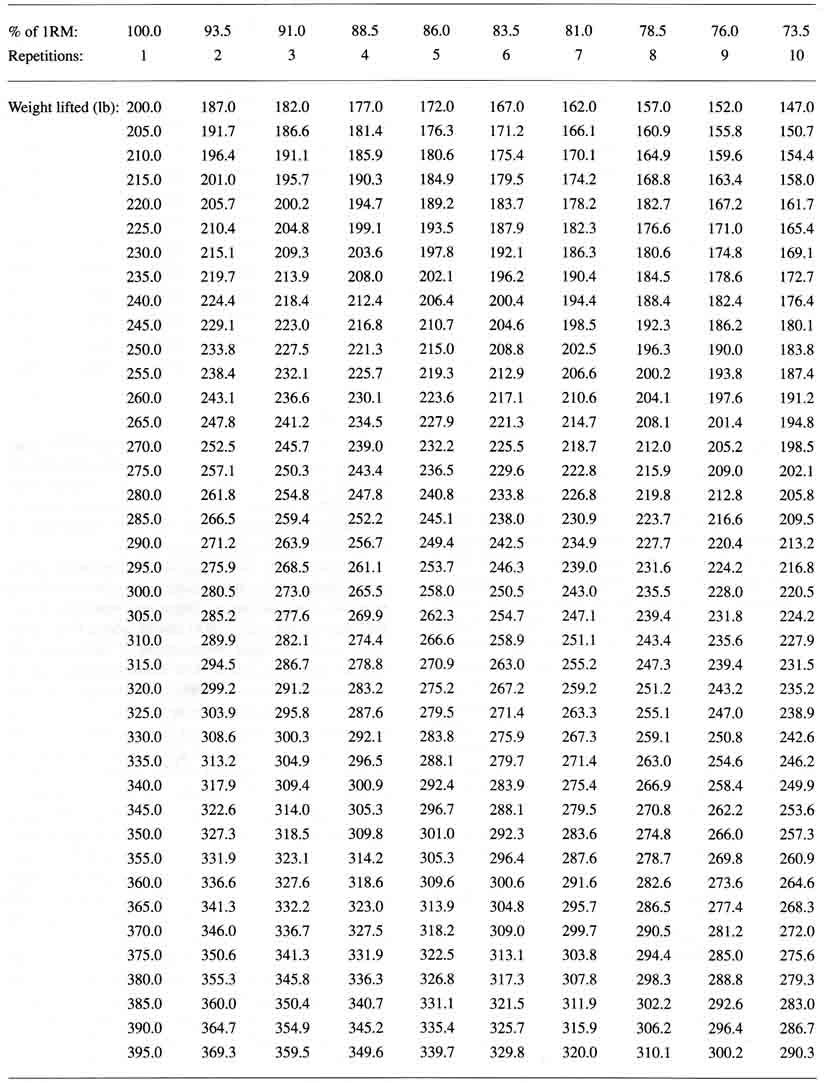
How to Use Load Assignment Chart
The Load Assignment Chart is Very Useful for Strength Training Programs
You can find a very close estimate of the amount of weight you can lift from this chart. Use the chart for the major multi-joint lifts such as dead lifts, squats, bench presses, military presses, power cleans and pull downs. Do not use it for isolation exercises such as biceps curls.
The Load Assignment Chart is Most Accurate if you use your 1RM or 1 rep Maximum Lift
Say your 1RM of bench press is 380. You want to do a set of 6. You can consult the chart and know that 317.3 is the weight to use for 6 reps if you want to a set of 6. The weight suggested by the chart is usually just right. You do not have to perform a 1RM to use the chart.
The Load Assignment Chart is just as Useful for Estimating Your 1 Rep Max
If you perform a set to failure with any weight, you can consult the chart to estimate your 1RM. Say you squat 300 pounds and are just able to perform 8 reps before you cannot perform another rep. Scroll down to 300 under 8 reps on the chart and follow the chart over to the left. Your 1RM would be around 380 pounds.
If you’re serious about strength gains, it is a good idea to print out the load assignment chart and bring it along to the gym every time you work out.
The Load Assignment Chart is Also Useful to Help Determine Training Volume, Training Splits, and Exercise Selection
- Weight Training Set Structure
Overview of different options for structuring the sets you use in your weight training workouts. - Training Volume
The amount of work done in a single workout. Training volume shows you a good estimate of your workout capacity. - Training Splits
Which body parts to do each workout to allow for proper rest. - Exercise Selection
Find a plethora of full-body exercises. Multi-joint exercises are best for weight loss.
How to Structure the Sets in Your Workouts
How you design your personal exercise program is completely up to you. There are different structures you should know about that you can use to help you meet your individual goals. In this article, we will go over different options for structuring the sets you use in your weight training workouts, comparing and contrasting the reasons you might choose one system over another.
If you are a beginning weight lifter and the terms “sets” and “reps” are new to you, check out our in-depth Sets and Reps section first. If you’re feeling good about the basics, keep reading to discover new and effective ways to structure your weight training sets that may not have occurred to you.
The Single-Set
As simple as it sounds: in the single-set weight training system, you’ll perform one set of an exercise, and then move on to the next exercise. You won’t repeat the exercises. The single-set system may be looked down upon by more advanced lifters who think it doesn’t stress the muscles enough for them to adapt. For advanced lifters, this may be true.
However, for beginners, the single-set weight training system may be the perfect way for them to ease into exercise without injuring the connective tissue or encouraging synergistic dominance (synergist muscles taking over the job of agonists, which leads to or exacerbates muscle imbalances).
If you choose the single-set system, perform your exercise routine at least 2-3 times per week to see gains in fitness.
The Multiple-Set
The classic way that many weight lifters structure their routines: one set is performed, then after a rest period, another set of the same exercise is performed at least one more time. The increased volume of work done as a factor of sets, reps, and intensity in a multiple-set system leads to faster gains for those beyond the beginning stages of weight training.
The Pyramid Set
The pyramid weight training system changes the weight and repetitions used in successive sets. You can start with light weights/high reps and progress to heavier weights/lower reps, or you can reverse it and start with heavy weights/low reps and progress to lighter weights/higher reps.
Pyramid sets help you build muscular endurance and strength concurrently instead of focusing on one or the other. Your body becomes accustomed to a wider variety of weight levels, and training in this varied way can help break plateaus if you are generally a straight multiple-set person.
Make sure to keep your form consistent in your pyramid sets. It’s common for the form to drop off as you progress to heavier weights when your muscles beginning to tire, so keep an eye on that and don’t let it happen!
The Superset
Supersetting refers to performing two exercises in rapid succession. Two main variations of the superset exist. In the “same muscle” variation, you will fatigue one muscle group by doing two different exercises for the same muscle group one right after the other. An example of the “same muscle” variation would be going from bench press straight into push ups to completely wipe out the chest muscles.
In the “agonist/antagonist” variation of the superset, you will perform an exercise for an agonist and then immediately perform an exercise for it antagonist. For example, you could superset the biceps with their antagonist the triceps by going from a bicep curl right into a tricep kickback. The advantage to the “agonist/antagonist” superset is that it minimizes recovery time while allowing large load to be placed on the agonist. In our example, when the biceps are recovering from the curls, the triceps are already being worked with the kickbacks.
Supersets don’t have to consist of only two stacked exercises; you can stack three (called a “tri-set”) or more (called a “giant set”) related exercises to further fatigue the muscles being worked.
Bodybuilders favor supersets because of their efficiency and effectiveness in both hypertrophy (muscle size) and endurance.
The Drop-Set
The drop-set system is also popular among bodybuilders due to this system’s effectiveness in encouraging hypertrophy and strength gains. Basically, a drop set allows you to push beyond the point in a set when you would normally stop.
A proper set in any set structure modality should end with failure. In a drop-set, you will perform one set with your desired weight to failure, then immediately reduce the load by a small amount (5-20%) and immediately perform another set for just a few reps.
The drop may be done once, twice, or even three times or more. A regular drop-set is one set to failure followed by one drop, while a “double-drop” is one set to failure followed by two subsequent drops, a “triple drop” refers to three drops…you get the idea.
Drop sets are considered an advanced weight lifting technique, and you should make sure you know what you’re doing before you attempt them, both to ensure your safety and to achieve maximum results.
Vertical Loading versus Horizontal Loading
So far, we’ve been talking in detail about how to structure sets themselves. Next, we’ll briefly go over two different options to consider when building the overarching structure of your workout routine.
Vertical loading refers to performing exercises for different body parts in sequence from head to toe. Vertical loading is done circuit-style, moving through each muscle group in sequence with minimal rest.
This is an efficient way to structure multiple sets if you’re using the multiple-set system. You won’t have to spend as much time recovering between exercises since you will essentially be resting each muscle group once you go on to the next group. By the time you’ve worked your way through your vertically loaded routine, your muscles will be rested enough to repeat the whole process without having to take any “official” rest breaks.
Vertical loading works great for folks with limited time who don’t have hours to spend in the gym. Vertical loading also encourages weight loss since the heart rate remains consistently high throughout the sequence.
In contrast to vertical loading, a horizontally loaded workout requires that you complete all your sets for a given muscle group before moving on. For example, if you plan to hit your chest, shoulders, and triceps during once workout session, you would complete all your chest exercise sets (with adequate rest between sets, of course) before moving on to shoulders. The same would go for shoulders before moving on to triceps.
The downside to horizontal training is the mandatory rest time between sets. This isn’t great news for most exercisers who have limited time to spend at the gym, and besides, typically care more about weight loss and lean muscle gain. However, bodybuilders and serious athletes may favor horizontal loading. In a horizontally loaded workout, the focus is on development of maximal strength and/or power for each muscle group. These types of training require longer rest periods anyway.
Final Thoughts
I hope you have found this information on weight training set structure helpful. It’s important to note that everyone’s body is different, and what works wonders for one person may not work at all for someone else.
Try different weight training methods to see what works best for you. As you get to know your body through strength training, it will become clear what methods produce your personal best results. Hire a personal trainer specializing in strength training if you want to maximize your workouts with minimal trial and error.
As I conclude, I want to briefly mention the concept of weight training splits. Splits are an important part of any weight training system. You need to get your splits right if you want maximum gains in muscle size, strength, and endurance! Splits refer to working different body parts on different days, efficiently allowing ample time for recovery between workouts, which prevents injury and leads to maximal gains. Read our article on Weight Training Splits for an exploration of this important concept.
About Michael Behnken
Mike Behnken is a personal trainer who holds multiple NASM certifications and a MS in Exercise Science. Mike loves fitness, travel, and photography among many other interests.

